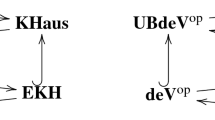Abstract
We define the notion of duality categories as generalization of duality groups. Two examples are treated. The first is the Serre duality in the categories of strict polynomial functors. The second concerns finite complexes. We show in particular that finite Tits buildings are duality categories.
Similar content being viewed by others
References
Abramenko, P., Brown, K.S.: Buildings Theory and Application. Springer, Berlin (2008)
Borceux F.: Handbook of Categorical Algebra 1. Cambridge University Press, Cambridge (1994)
Brown, K.S.: Cohomology of groups, Graduate Texts in Mathematics, vol. 87. Springer, New York (1982)
Bieri, R., Eckmann, B.: Groups with homological duality generalizing Poincaré duality. Invent Math. 20, 103–124 (1973)
Borel, A., al: Algebraic D-Modules Perspectives in Math. Academic Press, Florida (1987)
Chalupnik, M.: Koszul duality and extensions of exponential functors. Adv. Math. 218(3), 969–982 (2008)
Friedlander, E.M., Suslin, A.: Cohomology of finite group schemes over a field. Invent. Math. 127(2), 209–270 (1997)
Grothendieck, A.: Sur Quelques Points d’Algèbre Homologique. Tôhoku Math. J. 9, 119–221 (1957)
Hatcher, A.: Algebraic topology. Cambridge University Press, Cambridge (2002)
Krause, H.: Koszul, Ringel and Serre duality for strict polynomial functors. Compos. Math. 149, 996–1018 (2013)
Mac Lane, S.: Categories for the working mathematician. Springer, Berlin (1991)
Mac Lane, S.: Homology. Springer, Berlin (1975)
May, J.P.: Simplicial objects in algebraic topology. The university of Chicago Press (1967)
Munkres, J.R.: Topological results in combinatorics. Michigan Math. J. 31(1), 113–128 (1984)
Munkres, J.R.: Elements of Algebraic Topology. Addison-Wesley (1984)
Pirashvili, T., Introduction to functor homology, Rational representation, the Steenrod algebra and functor homology. Panoramas et synthèses. vol. 16 (2003)
Quillen, D.: Higher algebraic K-theory I, Lecture Notes in Math, vol. 341. Springer, Berlin (1973)
Reiten, I., Van Den Bergh, M.: Noetherian hereditary category satisfying Serre duality. J. Am. Math. Soc. 15(2), 295–366 (2002)
Touzé, A.: Ringel duality and derivatives of non-additive functors. Journal of Pure and Applied Algebra 217, 1642–1673 (2013)
Touzé, A.: Bar complexes and extensions of classical exponential functors (2013). arXiv:1012.2724v4 [math.RT]
Weibel, C.A.: An introduction to homological algebra. Cambridge University Press (1994)
Xu, F.: Lecture notes on representations and cohomology of categories. http://www.mat.uab.cat/xu/CatRepCoh.html (2011)
Author information
Authors and Affiliations
Corresponding author
Rights and permissions
About this article
Cite this article
Ksouri, R. Duality Categories. Appl Categor Struct 24, 283–314 (2016). https://doi.org/10.1007/s10485-015-9397-8
Received:
Accepted:
Published:
Issue Date:
DOI: https://doi.org/10.1007/s10485-015-9397-8




